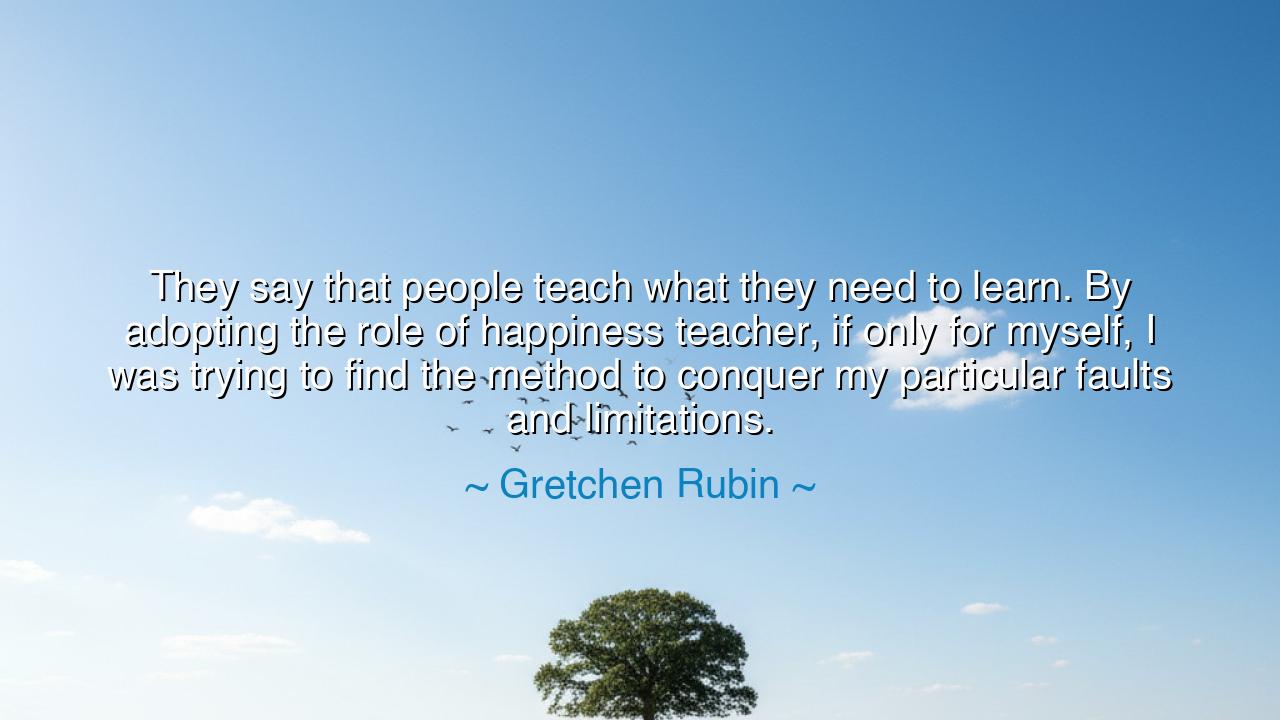
They say that people teach what they need to learn. By adopting
They say that people teach what they need to learn. By adopting the role of happiness teacher, if only for myself, I was trying to find the method to conquer my particular faults and limitations.






Gretchen Rubin once confessed: “They say that people teach what they need to learn. By adopting the role of happiness teacher, if only for myself, I was trying to find the method to conquer my particular faults and limitations.” These words, though spoken softly, resound like the wisdom of the ancients. They tell us that to teach is not always to stand above others, but often to stand among them—searching, stumbling, striving toward truth. In her own path, Rubin admits that her teaching of happiness was born not from perfect mastery, but from deep need. She was not a sage seated on a mountaintop; she was a seeker walking the same valley as those she sought to guide.
To say that we teach what we need to learn is to admit the humility of humanity. Even the wise have shadows, even the teacher bears wounds. In the ancient schools of philosophy, this was no shame. Socrates, who declared that he knew nothing, spent his life asking questions not because he had the answers, but because he longed for them. So too, Rubin’s quest for happiness was not the journey of one who already possessed it in abundance, but of one who sought to build it daily, brick by brick, and in the act of teaching others, strengthened her own foundations.
History provides us with luminous examples of this truth. Consider Mahatma Gandhi. He preached nonviolence, yet often confessed his own struggle with anger and impatience. In teaching peace, he was teaching himself, disciplining his spirit as he spoke to millions. His greatness was not in the perfection of his nature, but in the constancy of his striving. In this way, Rubin’s words echo Gandhi’s example: that the act of teaching is itself a mirror, revealing to the teacher where growth is still required.
Her phrase “to conquer my particular faults and limitations” carries the ring of battle. For the pursuit of happiness is not light or frivolous; it is a heroic struggle against the forces within—the restlessness, the dissatisfaction, the habits of despair. To stand as one’s own teacher of joy is to take up arms against these inner foes. It is no accident that the ancients spoke of philosophy as a training of the soul, a lifelong discipline. Rubin’s confession places her among these warriors of the spirit, who wrestle with their own shadows even as they light the way for others.
This teaching also reveals a profound paradox: the teacher and the student are often the same. One cannot guide another toward happiness without walking the path oneself. And so, to teach becomes a sacred form of accountability. The teacher who instructs others in kindness is compelled to be kind; the teacher of patience is reminded, daily, of their own anger. Thus, by adopting the role of happiness teacher, Rubin created for herself a mirror and a compass, forcing her to rise each day and practice what she preached.
The lesson for us is clear: do not wait to be perfect before you share what you know. Begin where you are. If you long for peace, then speak of peace, and in speaking, you will grow into it. If you seek wisdom, then share what little you have gathered, and in the sharing, your store will increase. To teach is to commit yourself to the path of learning, with witnesses. Do not despise your faults and limitations, for they may become the very soil from which your teaching grows.
Practical action follows: ask yourself, What do I most long to learn? Then, find a way to teach it—through writing, through mentoring, through example. If you seek discipline, guide another in discipline. If you desire joy, cultivate joy in community. Know that your imperfection does not disqualify you; it empowers you, for your teaching will not be lofty abstraction, but living struggle. In this way, you will grow alongside those you guide, step by step.
Thus Rubin’s words are not a confession of weakness but a hymn of strength. They remind us that the true teacher is not the flawless sage but the honest traveler, who dares to walk, stumble, and rise again in sight of others. To teach what we need to learn is to bind ourselves to growth, to transform our private longing into a shared journey. And in this, both teacher and student discover that happiness is not a distant prize, but a path walked together.






AAdministratorAdministrator
Welcome, honored guests. Please leave a comment, we will respond soon